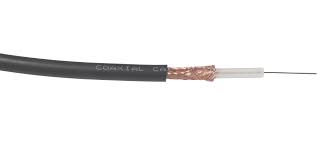In the world of coaxial cables, RG 59 cable stands out as a widely used option for transmitting audio and video signals. Known for its versatility and affordability, this cable is a popular choice in residential, commercial, and industrial applications. To better understand its role, it’s essential to explore its features, applications, and how it compares to similar options like the RG 6 cable.
What is RG 59 Cable?
RG 59 cable is a type of coaxial cable designed for low-frequency signal transmission. It consists of a central conductor, a dielectric insulator, a shielding layer, and an outer jacket. The cable’s design minimizes signal loss and protects the signal from external interference.
Its central conductor is typically made of copper or copper-clad steel, which ensures efficient signal transmission. The shielding, made of braided wires or foil, prevents electromagnetic interference (EMI), allowing the signal to remain intact even in environments with high electronic noise.
RG 59 is widely used for short-distance applications due to its higher attenuation rate compared to other coaxial cables. Its flexibility and thinner diameter make it easy to install, especially in tight spaces.
Key Features of RG 59 Cable
Signal Compatibility
RG 59 cable is best suited for analog video signals and lower-frequency applications. It works well with older video equipment, including CCTV systems and VCRs. The cable’s ability to handle frequencies up to 50 MHz makes it an excellent choice for specific applications where signal quality is critical.
Flexibility and Ease of Installation
The thinner diameter of RG 59 cable provides flexibility, making it easy to route through walls, ceilings, and conduits. This feature is particularly beneficial in residential installations where space may be limited. Its lightweight design also simplifies handling during installation.
Cost-Effectiveness
RG 59 is a cost-effective solution for many applications, offering reliable performance at an affordable price. Its lower material costs make it a budget-friendly option for large-scale installations, such as in apartment complexes or commercial buildings.
Applications of RG 59 Cable
Closed-Circuit Television (CCTV)
One of the most common uses of RG 59 cable is in CCTV systems. The cable provides a reliable connection between cameras and recording devices, ensuring clear video transmission. For short to medium distances, RG 59 delivers excellent performance, making it a staple in surveillance applications.
Broadcast Equipment
RG 59 is often used in broadcast systems for transmitting video signals from cameras to monitors or other equipment. Its compatibility with analog signals ensures that it remains a trusted option in professional video production environments.
Home Entertainment Systems
In residential settings, RG 59 cable connects TVs, VCRs, and other audio-visual devices. Its affordability and ease of installation make it a preferred choice for homeowners looking to set up or upgrade their entertainment systems.
Low-Power Signal Transmission
The cable is also suitable for transmitting low-power RF signals in applications such as ham radios or FM antennas. Its design minimizes signal loss, ensuring efficient transmission over short distances.
RG 59 Cable vs. RG 6 Cable: Key Differences
While RG 59 cable is an excellent option for certain applications, it’s essential to compare it with RG 6 cable to determine which is best suited for your needs. Both are types of coaxial cables, but they differ in several aspects:
Signal Frequency and Range
RG 6 cable is designed for higher-frequency signals and longer distances. It has a thicker dielectric and better shielding compared to RG 59, which reduces signal loss and interference. This makes RG 6 the preferred choice for digital applications, satellite TV, and broadband internet.
Cable Thickness and Flexibility
RG 6 cable is thicker and less flexible than RG 59, which can make installation more challenging in tight spaces. However, its thicker construction provides better protection against interference, making it ideal for environments with high electronic noise.
Applications
RG 59 is best suited for analog signals, short distances, and low-frequency applications. In contrast, RG 6 is optimized for digital signals, long-distance transmission, and high-frequency applications. Choosing the right cable depends on your specific requirements.
Cost
RG 59 cable is generally more affordable than RG 6, making it a cost-effective solution for applications where its performance is sufficient. However, for long-distance or high-frequency applications, the higher cost of RG 6 is justified by its superior performance.
Tips for Choosing the Right Cable
When selecting between RG 59 and RG 6 cable, consider the following factors:
- Application Requirements: Determine whether you need the cable for analog or digital signals, as well as the expected frequency range and distance.
- Installation Environment: Evaluate whether flexibility or resistance to interference is more important for your installation.
- Budget: Factor in the cost of the cable relative to your project size and performance needs.
- Signal Quality: If maintaining high-quality signals over long distances is crucial, RG 6 may be the better choice.
Conclusion
RG 59 cable remains a reliable and cost-effective solution for many audio and video applications. Its flexibility, ease of installation, and compatibility with analog signals make it a preferred choice in CCTV systems, home entertainment setups, and professional broadcasting. While it has limitations compared to RG 6 cable, its performance in specific scenarios ensures that it continues to be widely used. By understanding the strengths and differences between these cables, you can make an informed decision that best suits your signal transmission needs.
Also Read
- ► NeuroQuiet: Enhancing Hearing and Mental Clarity in New York
- ► Everything You Need to Know About MBA Admission 2025 and KM University’s Deadline
- ► Pawbiotix for Pets Gut Health Formula
- ► Hotel Management course in Rawalpindi Islamabad
- ► Top Interior Design Trends in Kuala Lumpur for 2025
- ► Tape Ball or Tennis Ball: How to Pick the Right One for Your Game
- ► Comparing Acrobat Reader and PDF Gear for Efficient PDF Management
- ► When to Use R Over Power BI for Data Projects
- ► Tips for Packing Efficiently with Movers
- ► Mechanics in Keilor: Expertise You Can Trust
- ► Marketing in a Web3 World: What Brands Need to Know
- ► Exploring the Role of Neuro-Marketing in Consumer Engagement
- ► How IoT is Shaping Hyper-Personalized Marketing
- ► How to Build a Sustainable Workplace Wellness Program
- ► Dalian’s Strategic Role in Spare Parts Transit




